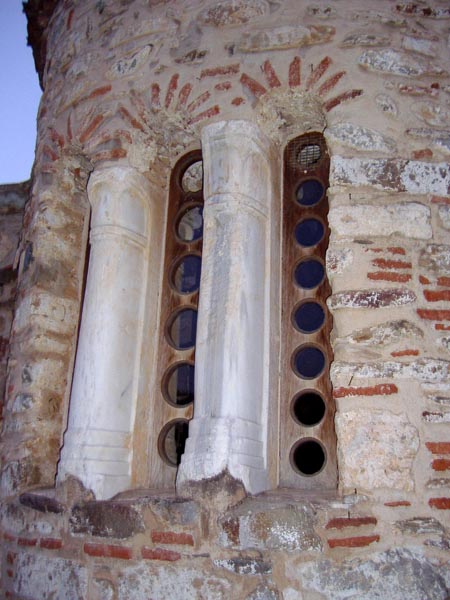Paleochristian and Byzantine Monuments Post- Byzantine Monuments
In an idyllic setting, at the root of the rock of Skotini (site of Skotini or Loumpinies) just 1km northwest of the settlement, stands the temple of Eisodia of Theotokos (Presentation of Mary), built over a paleochristian basilica.
The paleochristian Basilica of Fodele
A 6th century three section basilica 16 x 11, 30 m. The main section of the temple was separated from the altar with an iconostasis that bore marble columns. The sections were also divided by columns and the floor was adorned with small colourful marble cases in geometrical shapes.
The preserved parts of the Basilica include the exterior walls, the two columns that have been incorporated on the northern and southern wall of the newer church of Panaghia (Mary) and parts of the marbles in the second section.
The 11th Century Church of Eisodia tis Theotokou (Presentation of Mary)
A simple four-column vaulted temple of the hellenic school constructed on the central and eastern part of the paleochristian basilica.The architecture of the temple might belong to the Hellenic school; however, there are many decorative and structural elements that refer to the school of Constantinople. The interior is adorned with beautiful frescoes of three or four layers. The older layer dates back to the 11th century and it is considered extremely significant as is it is one of the few preserved samples of frescoed temples of this period in Crete, but also because of its high quality art.
Monastery of Aghios Panteleimonas
According to tradition, the Monastery was founded in the mid-17th century by the monks of the monastery of Aghios Antonios in Pera Galinon, after the latter was destroyed by the pirates. It is situated 4km south of the village of Fodele on a green slope with wild trees over the river of Mpefanis.The buildings were constructed in different time periods and the date on the inscription over the front gate (1677) probably refers to the year the constructions were completed and not to its foundation, as according to a 1670 Turkish document the monastery was functioning and receiving donations since 1670.In its initial phase, the monastery had a fortress – like character. In the center there was the main temple and around it extended the cells, kitchen, dining rooms, storerooms, guest houses ect. The fountain of the Monastery (30m from the entrance) is a small vaulted construction that bears an inscription informing us that it was renovated by monk Joseph in 1866. It is adorned with an anaglyph cross, flowers and lions.Historical references confirm that the monastery was one of the largest in Crete. The icons found in the main temple date back to the 17th, 18th and 19th century and are considered of great aesthetic value. The monastery also played a crucial role during the 1866 liberation battle, when it was used as a refuge for women and children and as a meeting point for rebel leaders. Today, two monks live in the monastery.
Aghios Panteleimonas in Papouri
Panaghia in Platani of Vasilikos
On the northwestern slope of mount Vasilikos (435m high), surrounded by streams
and platans, stands the renovated temple of Panaghia Zoodochos Pighi (Life
Giving Source). The original temple, as well as the ruins of 5-6 monk cells,
dates back to the Venetian period.
The Temple of Profitis Elias (Prophet Elias)
The temple of Profitis Elias is situated northwest of the temple of Aghios
Panteleimonas. It dates back to the Venetian period and it is partly built into
the natural rock.
Aghios Vasilios
According to a chart of Fr. Basilicata, the Venetian period settlement of Aghios
Vasilios was situated in the western bank of the river at the beach of the
village. The settlement took its name from the homonym temple and now lies in
ruins covered by the dense vegetation. A new temple was recently built dedicated
to the same saint, Aghios Vasilios.
Aghios Ioannis in Gialiskari
The temple of Aghios Ioannis is situated in the scenic cove of Gialiskari and
dates back to the Venetian period. It is also known as ‘Ai Giannis Dolmadas’
(from the word dolma) because according to a tradition the people of Fodele
organized a feast on the celebration day of the saint where the main dish served
was dolma (rice and vegetables stuffed in vine leafs).






